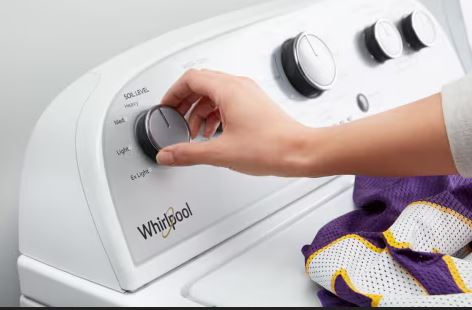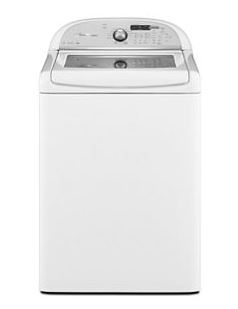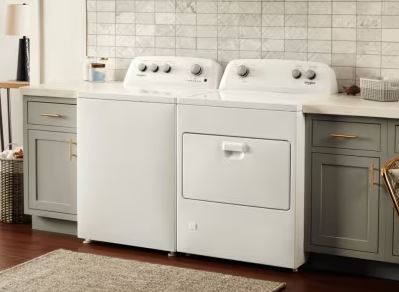Whirlpool Cabrio washer bearing problems aren’t too common, but when they do happen, they affect the general performance of your laundry machine. So, you should be able to identify them and replace the bearings in time to save money and your washer’s lifespan.
Common Whirlpool Cabrio washing machine problems include a loud noise during the spin cycle, a slow spin cycle, excessive shaking while spinning, a non-spinning washer, and the washer stopping mid-cycle.
So, we’ll look at five issues that could hit your Whirlpool Cabrio washer in case its drum bearings go bad. However, other issues could still cause the mentioned problems, not just bad bearings.
On that note, I’ll also mention the issues so you can consider them alongside the washer bearings. To make your diagnosis more conclusive, I’ll talk to you about how you can locate and examine the bearings for wear and rust under the replacement steps.
Without much further ado, let me explain what drum bearings are and what they do on your washer.

In a rush? Below is a summary of typical Whirlpool Cabrio washer bearing issues and other likely causes of the problems.
Whirlpool Cabrio Washer Bearing Problems Summary
| – | Problem | Other likely causes other than bad bearings |
| 1. | Loud noise during the spin cycle | Laundry imbalance or overload, loose foreign objects (in the drum), uneven washer, worn out shock absorbers, wrong laundry type, high RPM or excess suds, among others |
| 2. | Slow spin cycle (despite selecting a higher RPM) | Unbalanced load, excess suds, wrong spin setting, poor drainage, faulty belt, or motor malfunction |
| 3. | Excessive drum shaking during the spin cycle | Unbalanced washer, overloaded tub, high spin setting, loose shipping bolts, or worn-out shock absorbers |
| 4. | The washer won’t spin. | Jammed or unbalanced load, wrong setting, excess suds, power failure, error code, unbalanced washer or defective door switch, belt, motor, transmission, or control board |
| 5. | The washer stops mid-cycle. | Power supply fault, unbalanced load, faulty lid switch, clogged hose, defective inlet valve, or a bad timer, drive belt, motor pump, or control board. |
What Are Bearings On a Whirlpool Cabrio Washer?
Ball or tub bearings are small metal-like balls in a ring-like structure that support the drum as it rotates. So, their job is to enable the drum to spin smoothly.
You can locate the drum bearings at the back of a front loader or the bottom end of a top loader. In the case of a Whirlpool Cabrio, you can find them where the shaft and the inner tub connect.
What Are the Signs of a Bad Whirlpool Cabrio Washer Bearing?
Now that you know what drum bearings are and what they do, you may want to know how to tell when they are bad. Here are the signs to watch out for:
- Excessive noise during the spin cycle (loud spin cycle)
- Excessive vibration or shaking during the spin cycle
- Rusty bearings
- Slow RPM even after you raise the RPM.
- Worn-out bearings
What Are the Commonest Whirlpool Cabrio Washer Bearing Problems?
Once the drum bearings fail, a Whirlpool Cabrio washing machine may suffer any of these five problems:
1. Loud Spin Cycle
Defective bearings won’t correctly support the drum, which means the drum will make some noise while turning. Some notable high-pitch sounds that a Whirlpool Cabrio washer may create during the spin cycle include the following:
- Loud scraping sound
- Loud rumbling noise
- Jet engine sound
- Loud grinding sound
- Loud banging
- High-pitch whining
Note, however, that bad bearings aren’t the only thing that could cause the above noises.
Other Reasons
A washing machine may also have a very loud spin cycle due to these reasons:
a) Laundry unbalance or overload – Check if the clothes are out of balance or more than ¾ drum full. If they are fixed, that could be the reason your Cabrio washer won’t stop making a loud noise.
b) Loose foreign objects – Sometimes, things like coins, screws, keys, and other metal objects get caught in the drum, and when they do, the drum will make some weird loud noise during spinning.
c) Uneven washer – The drum won’t rotate smoothly if your Cabrio washer is out of balance. So, you must ensure the washer rests on an even surface. If its feet are loose, tighten them accordingly.
d) Wrong laundry type – Sometimes, a washer makes noise while spinning because the laundry is too bulky or just the wrong type. For example, you can expect a noisy spin cycle when washing mats, rugs, shoes, and other bulky items.
e) Higher RPM – Ideally, a washing machine’s spin speed should be about 800 – 1600 RPM. If you set it past 1600 RPM, the chances are that the drum will make some loud noise when spinning.
f) Excess suds – Sometimes a Whirlpool Cabrio washer makes a jet engine sound due to too many suds and not bad bearing. You could be putting too much detergent, causing the heavy Sudsing, or the detergent choice is wrong.
g) Worn-out shock absorbers – If the shock absorbers are worn out, they’ll fail to absorb the excess vibration, which means the drum will make some noise while spinning.
h) Other reasons – A Whirlpool Cabrio washer may also experience a loud spin cycle due to a defective drain pump, motor coupling, clutch assembly, or drive belt.

2. Slow Spin Cycle
As I mentioned earlier, a washer should spin at a speed of 800 – 1600 for the best wash results. Nevertheless, the washer sometimes won’t spin faster even if you raise the RPM. If that’s the case, the cause could be bad bearings. If it’s not the bearings, then it’s likely to be one of these reasons:
a) Unbalanced load – The laundry could be off-balance, thus stopping the drum from spinning smoothly.
b) Excess suds – Many suds will form if you are overapplying the detergent or using the wrong type, such as Non-HE. When they do, the washer will spin at a much slower pace.
c) Wrong spin setting – You must put your Cabrio washer on a high spin to spin fast. If you select a low spin setting, the washer will slow down.
d) Poor drainage – The wastewater has to drain out to allow the washer to spin smoothly. If that’s not the case, it’ll spin slowly or fail to turn.
e) Faulty belt – The drive belt turns the drum, which means the drum may fail to spin or may only turn slowly if the belt is defective.
f) Motor malfunction – The motor rotates the drum like the belt. If something is wrong, the drum may fail to spin entirely or only slowly.
3. Excessive Shaking During the Spin Cycle
An excessively shaking or vibrating drum could also be indicative of bad bearings. It could be that the bearings are failing to support the drum as it rotates. If it’s not the bearings, then the drum could be shaking excessively due to any of these reasons:
a) Unbalanced washer – The drum will shake during the spin cycle if your washing machine rests on an uneven surface or its feet are loose.
b) Overloaded tub – You shouldn’t load the washer past the recommended capacity (usually 3⁄4). If you do, the washer may produce some excessive vibration.
c) High spin setting – Expect your Cabrio washer to vibrate heavily and loudly if you set it on a setting above 1600 RPM. It should be 800 – 1600 RPM, but not anything above it.
d) Loose shipping bolts – If you have not fastened the shipping bolts, especially if your Cabrio washer is brand new, the drum will vibrate heavily. So, you ought to secure them before using the washer.
e) Worn-out shock absorbers –The shock absorbers’ job is to absorb the washer’s vibrations when it spins. That’s, however, possible when they wear out.
4. Washer won’t Spin
In a worse scenario, defective drum bearings will stop the drum from spinning since they fail to support it as it attempts to do so. Here are, however, some other possible reasons your Whirlpool Cabrio washer won’t spin:
a) Jammed or unbalanced load – The washer will have difficulty spinning if the clothes are excessive or just off balance.
b) Wrong setting – Unless you select a spin setting, your Cabrio washer won’t spin. It’s also essential to raise the spin setting instead of opting for a low spin.
c) Excessive suds – Suds, perhaps from detergent overuse, can stop a washer from spinning.
d) Power failure – Check if there has been a power failure, as it might have interfered with the spin cycle.
e) Error code – Sometimes, Whirlpool washers stop spinning when an error code appears on the display. Check if that’s the case.
f) Unbalanced washer – You can also expect the washer to have trouble spinning if it’s out of balance.
g) Others – Your Cabrio washer might also not spin due to a defective door switch, belt motor, transmission, or control board.
5. Washer Stops Mid-Cycle
Let’s discuss the last problem: a washer that won’t complete a cycle. Sometimes, a Whirlpool Cabrio washer stops mid-cycle due to bad drum bearings. But other than that, here are some other reasons a Whirlpool Cabrio washer won’t complete a wash cycle:
- Power supply fault (perhaps from using an extension cord over a wall socket)
- Unbalanced load
- Faulty lid switch
- Durian hose blockage
- Faulty water inlet valve
- Defective timer, drain pump, motor, drive belt, or main control board

Whirlpool Cabrio Washer Bearing Replacement
If the drum bearings are faulty, you can’t repair them. You’ve to replace them, and here’s what you’ll need:
- Whirlpool Cabrio washer bearing kit (get on Amazon) – The kit includes drum bearings, drive shaft, tub seal, shaft nut, spacer tube, adhesive lubricant and spacers
- Screwdriver set
- Pliers
- Spanner
The Process
Here’s how to replace the bearings in a Whirlpool Cabrio washer:
Step 1 (Turn off the washer) – Power off your washer and plug it out to avoid an electrician.
Step 2 (Get the replacement parts ready) – Ensure you have the requirements I’ve shared above, including the bearing replacement kit.
Step 3 (Disassemble the washer) – Remove the rear and front panels using the screwdriver to expose the bearings. Use the pliers to pull out the wiring.
Step 4 (Locate the bearings) – Locate the washer bearings where the inner tub and shaft meet at the bottom end of your washer. Quickly check it for damage, rust, or wear.
Step 5 (Remove the old bearings and examine them) – If you suspect the washer bearings are defective, loosen them with the spanner. Also, remove the bearing seal and observe them.
Step 6 (Fit the new bearings) – Install the replacement bearings with the tub seal and secure them.
Step 7 (Put everything back) – Return everything as it were.
Whirlpool Cabrio Washer Bearing Replacement Cost
The cost of replacing the bearings on your Whirlpool Cabrio washer depends on the model, where you buy the washer bearings, and whether you go DIY or hire a pro.
Hiring a washer expert will cost you $200 – $600, depending on the factors I’ve just mentioned. However, if you go DIY, you’ll only incur the bearing kit cost of about $50 – $100 if you have the other tools.
Concluding Thought
Above are the most typical Whirlpool Cabrio washer bearing problems, proving how critical the bearings are to the washer. So, the next time your Cabrio washer has a loud, slow, or excessively shaking spin cycle, fails to spin, or happens to stop mid-cycle, consider that it could be because of bad bearings. Don’t, however, overlook the other issues I’ve shared.
